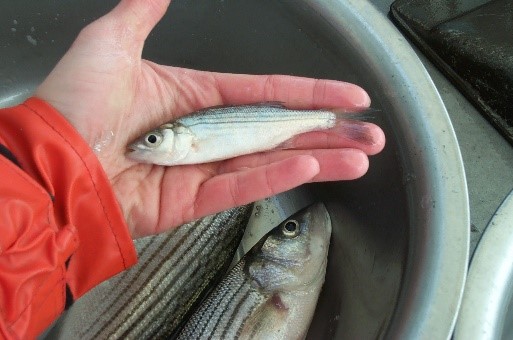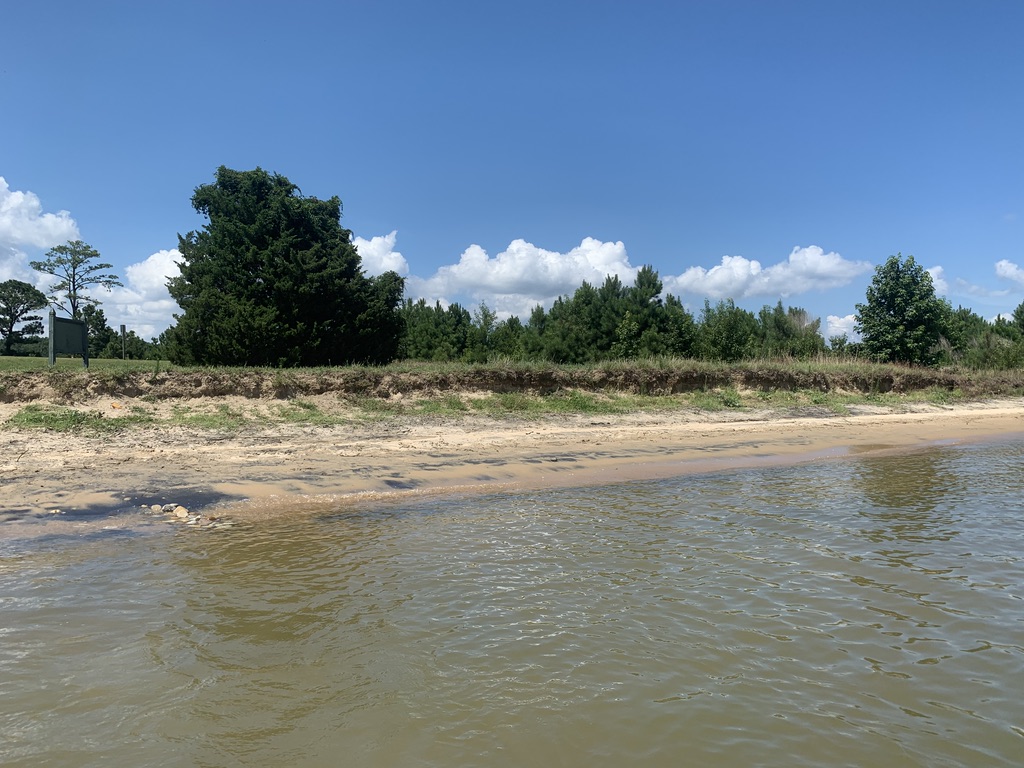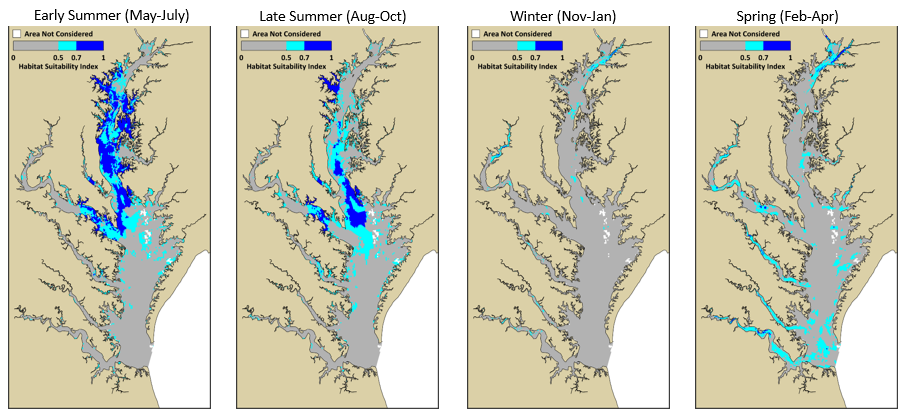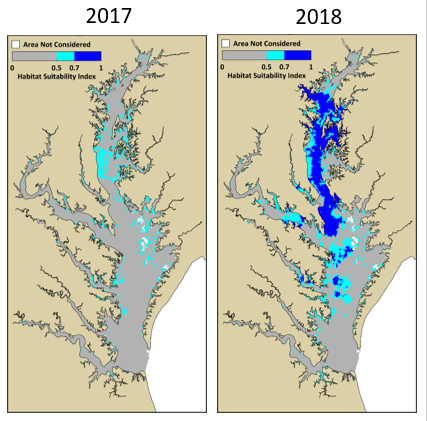Striped Bass Habitat
Research explores conditions that define suitable habitats for young striped bass in the Chesapeake.
 Striped bass (Morone saxatilis) support recreational and commercial fisheries along the Atlantic coast of the United States. The annual production of juvenile striped bass in estuarine nursery areas like Chesapeake Bay is critical to support these fisheries, but factors that contribute to high abundances of fish at this life stage are not fully understood.
Striped bass (Morone saxatilis) support recreational and commercial fisheries along the Atlantic coast of the United States. The annual production of juvenile striped bass in estuarine nursery areas like Chesapeake Bay is critical to support these fisheries, but factors that contribute to high abundances of fish at this life stage are not fully understood.
Habitat use by many estuarine fishes varies throughout their life cycle such that newly hatched fishes, young fishes, and mature adults may not use the same habitats. For anadromous fishes like striped bass, eggs hatch in the upper freshwater reaches of tidal tributaries and as they grow, larval and juvenile stages move downriver into more brackish, low-salinity environments. Striped bass remain in estuarine habitats for the first 2 to 4 years of life before they mature. Estuarine environments, however, are complex and characterized by large fluctuations in conditions across space and time. As a result, the extent and quality of suitable habitats for juvenile fishes such as striped bass likely also vary, partly in response to variations in seasonal and annual environmental conditions. A new study led by researchers at VIMS seeks to quantify and map habitats used by young striped bass and understand how the extent of high-quality habitats may affect abundance of this species in Chesapeake Bay.
Lead author on the study is Rachel Dixon, a Ph.D. student in the Fisheries Science department at VIMS. Co-authors include Drs. Mary Fabrizio and Troy Tuckey of VIMS, and Dr. Aaron Bever of Anchor QEA, LLC.
This study characterized habitat conditions in the Chesapeake Bay for two age groups of young striped bass: young-of-the-year (age-0) fish in shoreline and nearshore habitats, and age-1 to -4 fish Bay-wide. Catch data from 24 years (1996-2019) of monthly fisheries surveys conducted by VIMS and the Maryland Department of Natural Resources were coupled with output from a pair of computer models that simulate environmental conditions at each survey sampling site. These conditions include different measures of temperature, salinity, current speed, water depth, dissolved oxygen, and physical features of habitats. For each age group, we determined which combination of environmental conditions explained the variation in abundance of striped bass caught in the surveys. Dissolved oxygen and salinity consistently influenced fish abundance in both groups. Ultimately, habitat conditions varied across seasons and among years, reflecting changes in water quality conditions in Chesapeake Bay and changes in habitat use by striped bass during their first few years of life.
 These habitat conditions were used to develop a “habitat suitability index” for each age group of striped bass. Habitat suitability indices, ranging from 0 (poor habitat) to 1 (high-quality habitat), were used to map habitat on a seasonal and annual basis, where areas that scored > 0.5 were deemed “suitable”. This index revealed that shallow, nearshore areas in summer and habitats in the mainstem in spring, fall, and winter offered consistently suitable conditions for age-0 and age 1-4 striped bass. Mainstem channels, tributary channels, and the region along the eastern shore of the Bay offered persistent habitats that were suitable for age 1-4 fish in spring and fall. These results emphasize the need to protect habitats throughout the Bay in order to support the health of the population.
These habitat conditions were used to develop a “habitat suitability index” for each age group of striped bass. Habitat suitability indices, ranging from 0 (poor habitat) to 1 (high-quality habitat), were used to map habitat on a seasonal and annual basis, where areas that scored > 0.5 were deemed “suitable”. This index revealed that shallow, nearshore areas in summer and habitats in the mainstem in spring, fall, and winter offered consistently suitable conditions for age-0 and age 1-4 striped bass. Mainstem channels, tributary channels, and the region along the eastern shore of the Bay offered persistent habitats that were suitable for age 1-4 fish in spring and fall. These results emphasize the need to protect habitats throughout the Bay in order to support the health of the population.

Similar to many estuarine-dependent fishes, the abundance of striped bass in Chesapeake Bay is highly variable from year to year. Neither age group exhibited a significant relationship between the extent of suitable habitat and the abundance of striped bass observed in the various surveys. This suggests that the availability of high-quality habitat is currently not limiting population size for striped bass in Chesapeake Bay, however, the quantity of these suitable habitats is declining. A significant decrease in the extent of suitable habitat through time (1996 to present) was observed in spring and early summer, reflecting a change in suitable environmental conditions.
Overall, these results suggest that other biological factors not considered in this study (for example, prey availability, predation, or competition) could contribute to changes in habitat suitability for young striped bass in addition to fluctuations in water quality in Chesapeake Bay. Additional data will be required to monitor the availability and quantity of high-quality habitats at the scale of individual tributaries and Bay-wide, both of which may play an important role in production of this species.

Link to report on W&M ScholarWorks:
Rachel L. Dixon, Mary C. Fabrizio, Troy D. Tuckey, & Aaron J. Bever. (2022). Extent of Suitable Habitats for Juvenile Striped Bass: Dynamics and Implications for Recruitment in Chesapeake Bay. Virginia Institute of Marine Science, William & Mary. https://doi.org/10.25773/V87B-6B43

